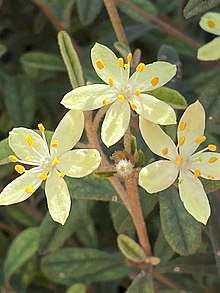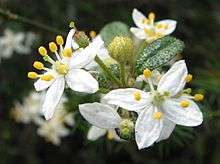Asterolasia asteriscophora
Asterolasia asteriscophora, commonly known as lemon starbush,[2] is a species of slender, erect shrub in the family Rutaceae and is endemic to southern continental Australia. It has woolly, star-shaped hairs on its young branches, variably-shaped leaves covered with brownish or whitish hairs on the underside, and yellow flowers with woolly brown, star-shaped hairs on the back.
| Lemon starbush | |
|---|---|
 | |
| Subspecies asteriscophora | |
 | |
| Subspecies albiflora in Emerald | |
| Scientific classification | |
| Kingdom: | Plantae |
| Clade: | Tracheophytes |
| Clade: | Angiosperms |
| Clade: | Eudicots |
| Clade: | Rosids |
| Order: | Sapindales |
| Family: | Rutaceae |
| Genus: | Asterolasia |
| Species: | A. asteriscophora |
| Binomial name | |
| Asterolasia asteriscophora | |
| Synonyms[1] | |
| |
Description
Asterolasia asteriscophora is a slender, erect shrub that typically grows to a height of 1–2 m (3 ft 3 in–6 ft 7 in) with its young branches covered with woolly, grey to brown star-shaped hairs. The leaves are spatula-shaped, egg-shaped, wedge-shaped or elliptic, 3–30 mm (0.12–1.18 in) long and 2–10 mm (0.079–0.394 in) wide on a short petiole. The upper surface of the leaves is more or less glabrous and the lower surface is covered with woolly, brownish or whitish hairs. The flowers are arranged singly or in small groups in leaf axils or on the ends of branchlets on pedicels 2–20 mm (0.079–0.787 in) long. The petals are yellow, rarely white, 5–7 mm (0.20–0.28 in) long and covered with woolly brown star-shaped hairs on the back. Flowering occurs in spring.[2][3][4][5][6]
Taxonomy
This species was first described in 1855 by Ferdinand von Mueller who gave it the name Phebalium asteriscophora and published the description in Transactions and Proceedings of the Victorian Institute for the Advancement of Science.[7][8] In 1917 George Claridge Druce changed the name to Asterolasia asteriscophora.[9][10]
In 2002, Bryan J. Mole described two subspecies and the names have been accepted by the Australian Plant Census:
- Asterolasia asteriscophora subsp. albiflora[11] that has white, rarely pale lemon-coloured petals with smaller leaves and flowers that the autonym;
- Asterolasia asteriscophora subsp. asteriscophora[12] that has bright yellow petals up to 6 mm (0.24 in) long and leaves mostly longer than 12 mm (0.47 in).[6]
Distribution and habitat
Asterolasia asteriscophora is widely distributed along the Great Dividing Range from the Tumut district in New South Wales to the Macedon and Emerald districts in Victoria. It grows in forest and along the eges of watercourses.[6] Subspecies albiflora is only known from the Emerald-Avonsleigh and is threatened by urban development.[6]
References
- "Asterolasia asteriscophora". Australian Plant Census. Retrieved 25 June 2020.
- "Asterolasia asteriscophora". Royal Botanic Garden Sydney. Retrieved 25 June 2020.
- Duretto, Marco F. "Asterolasia asteriscophora". Royal Botanic Gardens Victoria. Retrieved 25 June 2020.
- Wilson, Paul G. "Asterolasia asteriscophora (F.Muell.)". Australian Biological Resources Study, Department of Agriculture, Water and the Environment, Canberra. Retrieved 24 June 2020.
- Corrick, M.G. & Fuhrer, B.A. (2001). Wildflowers of Victoria and adjoining areas. Australia: Bloomings Books. ISBN 1876473142.
- Mole, Bryan J. (2002). "Variation within Asterolasia asteriscophora sensu lato (Rutaceae: Boronieae) and the recognition of new taxa in eastern Australia". Muelleria. 16: 101–105. Retrieved 25 June 2020.
- "Phebalium asteriscophora". APNI. Retrieved 25 June 2020.
- von Mueller, Ferdinand (1855). "Description of fifty new Australian plants, chiefly from the colony of Victoria". Transactions and Proceedings of the Victorian Institute for the Advancement of Science. 1: 31. Retrieved 25 June 2020.
- "Asterolasia asteriscophora". APNI. Retrieved 25 June 2020.
- Druce, George Claridge (1917). "Nomenclatorial Notes: chiefly African and Australian". The Botanical Exchange Club and Society of the British Isles Report for 1916, Suppl. 2. 4: 606. Retrieved 25 June 2020.
- "Asterolasia asteriscophora subsp. albiflora". Australian Plant Census. Retrieved 25 June 2020.
- "Asterolasia asteriscophora subsp. asteriscophora". Australian Plant Census. Retrieved 25 June 2020.